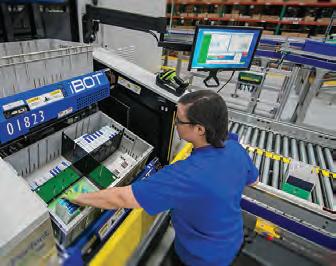THE PUSH TOWARD SUSTAINABILITY
How ports, rail and business are looking at greener initiatives

› The advantages of sustainability
› A career in the supply chain sector
› The circular tire supply chain

How ports, rail and business are looking at greener initiatives

› The advantages of sustainability
› A career in the supply chain sector
› The circular tire supply chain

• Industry-leading Canada & USA LTL utilizing innovative technologies
• Digitized, automated processes simplifying the customer experience
• Real-time cross border route optimization limiting turbulence in transit
• Proactive, direct communications from the driver’s seat to ground control
• Predictive IoT device integration for live asset monitoring
• Clear visibility with visual tracking & instant travel notifications


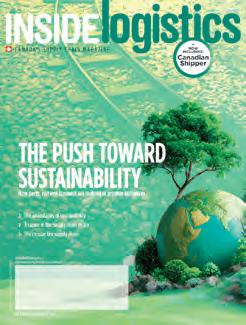

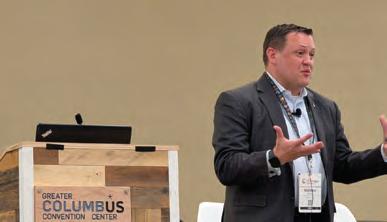
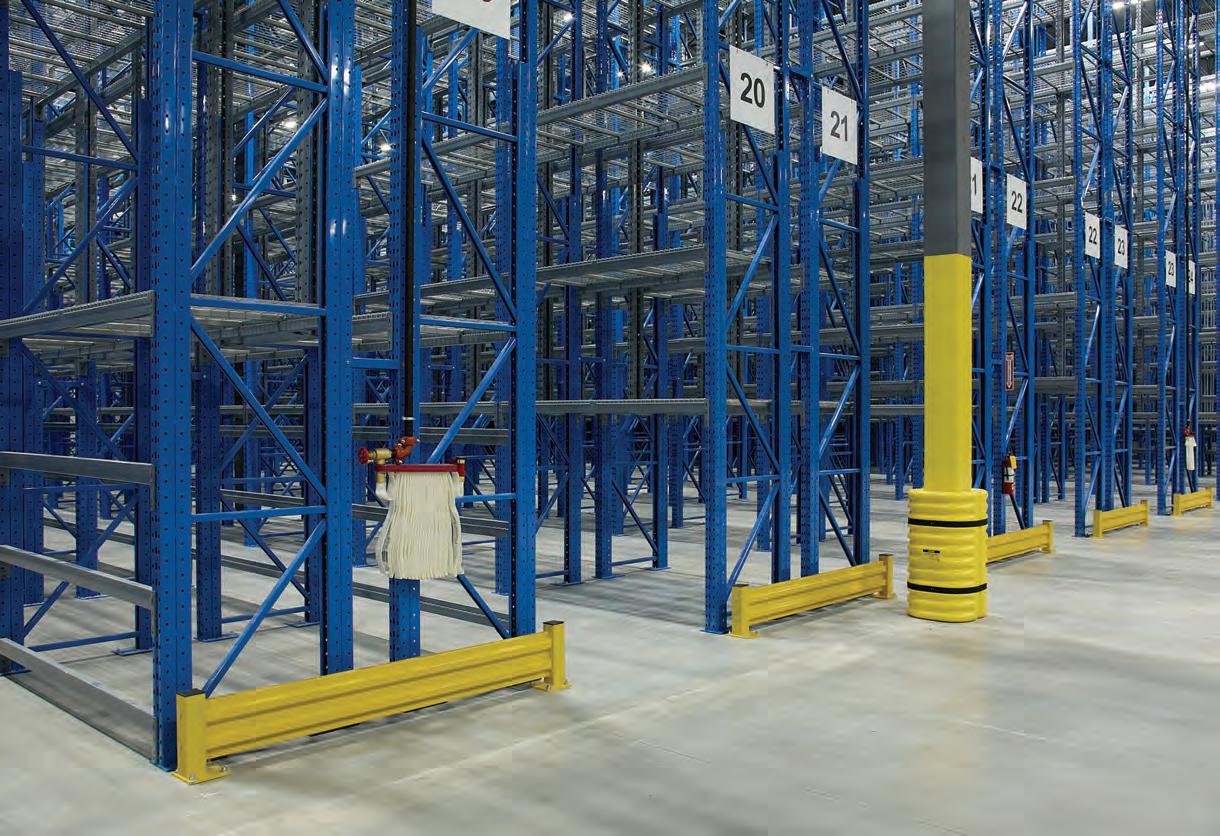
Publisher | Delon Rashid (416) 459-0063 delon@turnkey.media
Editor | Derek Clouthier (416) 605-5346 derek@turnkey.media
Contributing Writers | Victoria Jones, Carl Bonello
Creative Director | Samantha Jackson
Video / Audio Engineer | Ashley Mikalauskas, Nicholas Paddison
Sales | Delon Rashid, (416) 459-0063 delon@turnkey.media
Peter Bulmer, (585) 653-6768 peter@turnkey.media
Production and Ad-ops | Tracy Stone tracy@turnkey.media
Inside Logistics magazine is published by Turnkey Media Solutions Inc. All rights reserved. Printed in Canada. The contents of this publication may not be reproduced or transmitted in any form, either in part or full, including photocopying and recording, without the written consent of the copyright owner. Nor may any part of this publication be stored in a retrieval system of any nature without prior consent.
Canada Post Canadian Publications Mail Sales Product Agreement No. 43734062
“Return Postage Guaranteed” Send change of address notices, undeliverable copies and subscription orders to: Circulation Dept., Inside Logistics magazine, 48 Lumsden Crescent, Whitby, ON, L1R 1G5
Inside Logistics magazine (ISSN No.: 0025-5343 (Print); 1929-6460 (Digital) is published six times per year by Turnkey Media Solutions Inc., 48 Lumsden Crescent, Whitby, ON, L1R 1G5
From time to time we make our subscription list available to select companies and organizations whose product or service may interest you. If you do not wish your contact information to be made available, please contact us.
President & Managing Partner | Delon Rashid Head of Sales & Managing Partner | Peter Bulmer
Corporate Office
48 Lumsden Crescent, Whitby, ON, L1R 1G5

ISSN 0025-5343 Online 1929-6460


SUSTAINABILITY HAS GOTTEN A bad rap over the past few years — some of it justified, some not.
After all, greenhouse gas (GHG) emissions have been steadily increasing over the past decade despite government efforts to regulate change. Ocean shipping, according to the Marine Development journal, rose 12 per cent between 2016 and 2023. Trucking is no different, with emissions in North America continuing to rise, particularly in Canada, which saw a nearly 35 per cent increase between 2005 and 2019, according to Statistics Canada. Even rail saw a 0.8 per cent rise in emissions. But, as with many other modes of transportation, much of the increase in GHG emissions is due to more activity, which of course stems from higher demand.
A lot of the pushback we have seen recently on sustainability initiatives comes from the very efforts governments have made to curb emissions. You could argue that regulating change forces industry’s hand in a way it otherwise would not. But you could also argue that forcing change simply does not work — especially when the technology, infrastructure or other enabling factors are not yet ready.
After all, sustainability — the theme of this issue — is not simply about lowering emissions. It is a much broader initiative that helps industries reduce costs, streamline processes, increase productivity and, yes, lessen their carbon footprint.
At least it should.
Too often we see governments take the wrong approach to helping industry lower its carbon footprint. Carbon taxes, for example. The intent is to create an incentive to emit less and drive innovation. And though some studies have shown carbon taxes can achieve these goals, there are better ways to encourage innovation than charging for complacency. On a more individual scale, for example, people’s driving habits do not change simply because they pay a few more cents at the pump. In this sense, the carbon tax is little more than another revenue stream for government.
Instead, there should be more education on how sustainability improves a business model, more incentives for those who innovate and deliver results, and much less reliance on government, which too often does what it does best — collect money.

U.S. suspension of de minimis to hit Canadian exporters
Montreal Port Authority, DP World sign deal
9 MOVERS + SHAKERS
Appointments and promotions
14
By Inside Logistics Staff

CANADA POST’S WORKERS’ UNION has declared a nationwide strike after the federal government moved to remove long-standing restrictions on the Crown corporation, which is grappling with growing financial losses.
Canada Post stated it is disappointed that the union opted to increase strike action, warning it will worsen the corporation’s already precarious financial position.
Canada Post operations will shut down during a national strike, affecting millions of Canadians and businesses across the country.
“Canada Post is now facing an existential crisis,” said Joël Lightbound, minister of government transformation, public works and procurement. “Since 2018, the corporation has accumulated more than $5 billion in losses. In 2024 alone, it lost over $1 billion, and in 2025, it is already on track to lose close to $1.5 billion.”
The Canadian Union of Postal Workers (CUPW) said Lightbound announced the government was accepting and instructing Canada Post to implement the recommendations from William Kaplan’s Industrial Inquiry Commission (IIC) report from May. The recommendations include converting four million addresses to community mailboxes, removing the rural moratorium on post office closures, giving Canada Post more flexibility
in its delivery standards — including cutting the requirement to deliver five days a week — and allowing the corporation to raise stamp rates more frequently.
“This announcement was an outrage,” CUPW said in a release. “Minister Lightbound gave the union no indication that he was going to do this when leadership met with him last week. The minister said he had the ‘utmost respect’ for postal workers. This is no way to show it.”
Lightbound said the measures could save hundreds of millions of dollars annually.
“Canada Post is a vital national institution worth preserving,” he said. “The measures announced today will help place the corporation on a stronger financial footing and provide the flexibility it needs to adapt to a rapidly changing environment.”
Canada Post said customers should expect delays in mail service, as mail and parcels will not be processed or delivered for the duration of the national strike, and some post offices will be closed. Service guarantees are suspended for items already in the postal network, and no new items will be accepted until the disruption is over.
“All mail and parcels in the postal network will be secured and delivered as quickly as possible once operations resume,” Canada Post said. “However, a national strike of any length will impact service to Canadians and
businesses well after the strike activity ends. Processing and delivery may take some time to fully return to normal.”
Canada Post and CUPW have agreed to continue the delivery of socio-economic cheques during any labour disruption for eligible and participating government organizations.
A process is also in place to ensure existing live animal shipments continue during the disruption, though no new shipments will be accepted.
Canada Post had welcomed the government’s announcement, citing years of declining letter mail and growing delivery costs.
“Canadians cannot continue to pay more through their taxes for a service they use less and less,” the corporation said.
President and CEO Doug Ettinger said the changes will help ensure the postal service can adapt.
“Today’s announcement will allow us to make the changes needed to restore Canada’s postal service for all Canadians by evolving to better meet their needs,” he said.
CANADA HAS THE CHANCE to redirect $12 billion in food and beverage exports toward markets outside the U.S., according to a new Farm Credit Canada report.
The study, The $12-billion trade shift: Canada’s opportunity to diversify food exports beyond the U.S., notes that in 2023 more than 75 per cent of Canadian food and beverage exports were destined for the U.S., exposing producers to potential risks from changing trade conditions.
“Canadian agriculture and food producers rely on international trade to thrive, but ongoing trade disruptions have created uncertainty and barriers to growth,” said Justine Hendricks, FCC president and CEO. “Diversifying food and beverage exports beyond the U.S. will not only strengthen producers’ resilience but also benefit Canadian consum -
ers and the broader economy.”
The report outlines a three-part strategy: strengthen inter-provincial trade, maximize existing free trade agreements with 51 countries and pursue new international partnerships in Europe, Asia and Latin America.
J.P. Gervais, FCC’s chief economist, said shifting $12 billion in exports will reduce risk and stabilize the industry. “A balanced trade portfolio will make the ag and food industry more competitive, adaptable and prepared to succeed in a changing global economy,” he said.
The report also points to promoting the “Buy Canadian” movement, investing in infrastructure and innovation and expanding domestic value-added processing as ways to capture more market share at home and abroad.




CANADIAN BUSINESSES SELLING low-value goods to U.S. customers are preparing for added costs and paperwork after Washington announced it ended its long-standing de minimis exemption for commercial shipments, according to MNP partner Mike Cristea.
Starting Aug. 29, all shipments entering the U.S., regardless of value, require full customs documentation and may be subject to duties. Goods that qualify under the





Enjoy the benefits of affiliate membership with Canada’s Logistics Association
CITT is Canada’s Logistics Association and the home of Canada’s logistics community. If you’re involved in the business of logistics in Canada, officially join your national community of practice today!
As a member of CITT:
Be well-connected. Join Canada’s most interactive logistics community for networking events, online idea-sharing, exclusive job opportunities and more.
Be informed. Access industry reports, free webinars, and priority registration to professional development opportunities.
Be recognized. You’ll get a fully verified digital credential identifying you as part of Canada’s most respected logistics organization. Learn more & join today at
Canada-U.S.-Mexico Agreement (CUSMA) remain duty-free, but companies need to demonstrate compliance with the trade pact’s rules of origin.
The de minimis exemption, set under Section 321 of the Tariff Act of 1930, allows imports valued at US$800 or less to enter duty- and tax-free. It was expanded in 2016 to encourage e-commerce, but U.S. officials say the suspension is part of a broader push to curb tariff evasion, counterfeits and illicit imports.
MNP, a Canadian accounting and consulting firm, says the change poses significant challenges for small and medium-sized exporters that lack the infrastructure of larger corporations.
“The de minimis threshold has allowed a frictionless flow of goods across the border,” the firm wrote in a recent report. “Its suspension will add complexity, increase costs and force businesses to make strategic decisions about fulfillment, sourcing and compliance.”
Among those most affected will be online sellers shipping through platforms like Etsy or Shopify, subscription-box companies, drop shippers and B2B exporters of small components. These firms will now face higher landed costs, longer delivery times and complicated return procedures.
Businesses that import parts from outside North America for assembly in Canada are also at risk. Unless their products meet strict CUSMA rules, they could face tariffs of up to 35 per cent when entering the U.S.
To adapt, MNP recommends exporters re-evaluate supply chains to favour CUSMA-compliant inputs, consider bulk shipping and U.S. warehousing and strengthen customs compliance systems. Investments in automation, recordkeeping and trade advisory services could also help avoid delays and penalties.
The firm also urges companies to communicate openly with U.S. customers about potential price increases and delivery changes.
“The suspension introduces new complexity, but it also presents an opportunity for businesses to reassess their cross-border strategies,” the report said.
For many Canadian exporters, the end of the exemption may mean absorbing higher costs or passing them along to American buyers.
CANADIAN EXPORTERS ARE showing declining confidence amid mounting global trade challenges, according to Export Development Canada.
Its most recent Trade Confidence Index has dropped to one of the lowest levels ever recorded. The summer 2025 survey of more than 1,000 companies shows the index fell 3.3 points from late 2024 to 65.7, significantly below the long-term average. EDC notes confidence has dipped lower only during the 2008 financial crisis, the COVID-19 pandemic and the inflation surge that followed.
Among exporters, 40 per cent reported a decline in U.S. orders in the past six months, up sharply from 16 per cent in the previous survey. More than a third expect further drops in the coming months, while many also anticipate domestic sales will take a hit from tariffs.
Companies cited cash flow, higher oper-

ating costs and access to financing as top hurdles.
Despite the challenges, exporters are pursuing new markets and boosting domestic sales to diversify. But EDC says the use of free trade agreements remains limited, with only 34 per cent of eligible firms tapping into the Canada-EU trade deal and just 14 per cent using the Trans-Pacific pact.
EDC has published the index twice a year since 1999 to track the outlook of Canadian exporters.
THE MONTREAL PORT AUTHORITY (MPA) has entered into a joint development agreement with DP World in Canada to plan land-based infrastructure for the proposed container terminal in Contrecœur. Finalized Sept. 4, the agreement designates DP World as an active terminal operator at the Port of Montreal.
Already managing five port facilities in Canada, the company will handle the construction and operation of the container yard, buildings, utilities and rail connection at the new terminal.
“The agreement with DP World here in Canada marks a decisive step in realizing the Port of Montreal expansion project in Contrecœur,” said Julie Gascon, president and CEO of the MPA. “By leveraging innovation, sustainability and the expertise of a world-class partner, we are strengthening the Port of Montreal’s strategic role as an economic engine for Quebec and Canada.”
Doug Smith, CEO of DP World in Can-
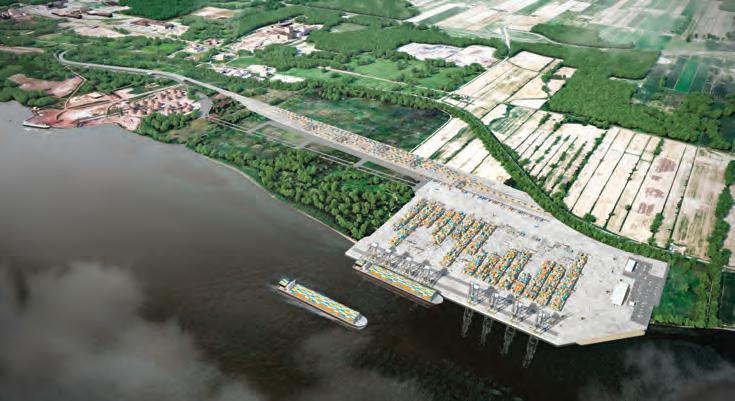
ada, said the terminal will act as “a true economic engine for Quebec and Eastern Canada, creating thousands of jobs during construction and driving long-term prosperity through expanded trade capacity.”
The port authority expects land preparation to begin in 2025, with in-water works starting in 2026, land-based works in 2027 and the terminal’s completion in 2030.
AMAZON IS BROADENING its Multi-Channel Fulfillment (MCF) service to assist merchants selling on SHEIN, Shopify and Walmart.
The announcement was made at the company’s Accelerate seller conference, where Amazon said the expansion adds to its current integrations with eBay, Etsy, Temu and TikTok Shop. By sharing inventory with Fulfillment by Amazon, MCF allows businesses to streamline operations, cut costs and boost sales across multiple online platforms.


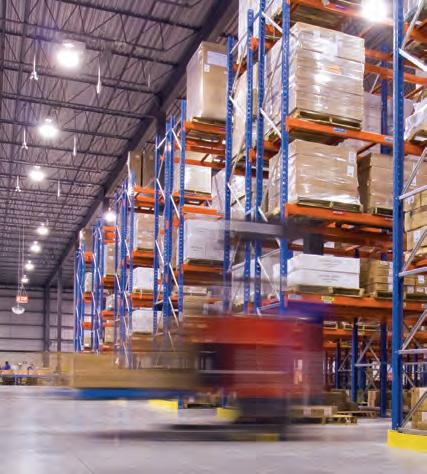
Johnston Equipment and our family of companies support your facility through design, implementation and ongoing optimization—delivering smarter solutions to help you move more, faster.
“Amazon’s world-class fulfillment network delights customers with fast, reliable delivery— fueling the success of independent sellers in the U.S. and around the world,” said Peter Larsen, vice-president of Amazon Multichannel Commerce & Fulfillment. “By working with SHEIN, Shopify and Walmart, we’re making it easier for sellers—especially the small and medium-sized businesses that drive our economy—to use our network to grow faster and more efficiently across their sales channels.”
The company said merchants will be able to manage orders from the new platforms through integrations with Seller Central, Shopify’s Fulfillment Network and Walmart Marketplace, giving them access to faster delivery, order tracking and inventory synchronization.
Amazon says MCF currently operates in 11 countries and has helped merchants cut outof-stock rates by an average of 19 per cent while improving turnover and sales.

CANADIAN IMPORTERS AND EXPORTERS
should prepare for ongoing supply chain disruptions as peak season approaches, with new tariffs, port congestion and inland transport bottlenecks driving higher costs and complexity, according to Maersk’s latest North America market update.
The global shipping company noted that low water levels on the St. Lawrence River are restricting vessel capacity into Canada, making planning more difficult for businesses already dealing with variable lead times and changing trade flows. On the East Coast, Montreal congestion is worsened by major roadwork at Turcot, Ville Marie and the La Fontaine Tunnel, while high dwell times in Newark are delaying Canada-bound rail shipments.
Reefer trucking into Canada is especially tight. Maersk urged shippers to book refrigerated equipment earlier than usual and build up safety stock to buffer against late arrivals. The company also recommended flexible Montreal delivery windows and considering alternative inland ramps or gateways to avoid bottlenecks.
“Plan Canada moves with added lead time and keep Montreal delivery windows flexible to account for variable discharge and roadworks,” the company said in its update.
The report comes as Ottawa moves to ease some trade frictions. Prime Minister Mark Carney announced that, effective Sept. 1, tariffs on most U.S.-origin goods under the Canada-U.S.-Mexico Agreement (CUSMA) will be lifted, though 25 per cent duties remain in place for steel, aluminum and automotive products. Maersk said Canadian importers should review sourcing strategies to take advantage of the relief once full Canada Border Services Agency guidance is released.
At the same time, shippers are grappling with the fallout from Washington’s suspension of the de minimis exemption for small parcels, which previously allowed duty-free clearance for goods under US$800. Maersk said the change is particularly disruptive for e-commerce and small parcel flows, increasing the need for customs brokerage and accurate product classification.
Inland logistics in Canada remain active, supported by sustained West Coast volumes and steady demand across retail and wholesale sectors. Ground freight activity is showing

early signs of recovery following tariff-related slowdowns, aided by a gradual rebound in construction and manufacturing. Maersk advised businesses to secure mid-term capacity now, especially in Western Canada and along infrastructure-heavy corridors, to guard against sudden spikes in demand.
Maersk urged shippers to book refrigerated equipment earlier than usual and build up safety stock to buffer against late arrivals.
– Maersk North American update
Warehousing conditions across North America remain mixed, with smaller facilities still tight while larger spaces are more flexible. Bonded and free trade zone-enabled facilities are seeing increased demand as shippers seek to defer duties and manage landed costs. Maersk said Canadian businesses should reassess inventory positioning and consider diversifying distribution across multiple port entries to reduce risk.
Despite the challenges, Maersk reported its East-West Gemini network continues to post strong schedule reliability, with 100 per cent performance into the U.S. West Coast and 93.1 per cent into the East Coast, both well above industry averages.
The company cautioned that volatility will persist through the remainder of 2025 as tariff regimes shift and seasonal surges test capacity. It urged Canadian companies to pressure-test their supply chains, build visibility into their logistics networks and keep contingency plans ready.
PET VALU HOLDINGS LTD. has wrapped up its fouryear supply chain overhaul with the launch of a 295,000-square-foot, LEED Gold-certified distribution centre in Calgary.
The $100-million project consolidates nine warehouses into three modern, partially automated centres located in Brampton, Ont., Surrey, B.C., and Calgary, providing the company with over 1.3 million square feet of total capacity. The Calgary facility is anticipated to create more than 100 jobs and support growth throughout Alberta, Saskatchewan and Manitoba.
“We are thrilled to officially unveil our new Calgary DC, the final pillar of our modernized supply chain, serving Canadian franchisees and devoted pet lovers coast-to-coast,” said Richard Maltsbarger, CEO of Pet Valu.
“With over 1.3 million square feet of distribution capacity, supported by industry-leading automation and technology, we have successfully built Canada’s strongest supply chain supporting the pet specialty industry,” added Nico Weidel, chief supply chain officer.

Hybrid Security combines ECAM’s AI-powered technology with GardaWorld’s expert manned guarding services for fast, efficient protection.
With 24/7 monitoring, real-time alerts, and seamless integration, we offer proactive threat detection, rapid response, and cost-effective security that’s tailored to your needs.
garda.com/hybrid-security

THE CANADA INFRASTRUCTURE BANK (CIB) has approved a $100 million loan to Cando Rail & Terminals to expand its Sturgeon Terminal in Alberta’s Industrial Heartland, doubling the facility’s rail capacity.
The expansion will provide up to 3,700 additional railcar storage and staging spaces, including 1,100 for unit trains, and is expected to generate 50 full-time jobs while contributing $22.3 million annually to the regional economy. Construction is already underway, with operations scheduled to start in late 2026.
“Expansion of the Sturgeon Terminal opens up more opportunities for Alberta businesses to connect their products to global markets,” said Ehren Cory, CEO of the CIB.
Tim Hodgson, minister of energy and natural resources, said, “Western Canada is key to become an energy, natural resources and trade superpower. The new federal government is focused on getting Canadian goods to market, and through the CIB’s $100 million investment in the Sturgeon Terminal, Cando Rail will be able to catalyze new productivity and further strengthen supply chains.”
“As Cando Rail & Terminals works to expand capacity at our rail terminal in Alberta’s Industrial Heartland, support from partners such as the Canada Infrastructure Bank enables us to provide access to increased transportation and logistics solutions to our customers at an accelerated pace,” added Brian Cornick, president and CEO of Cando Rail & Terminals.
TRIMAC TRANSPORTATION
purchased Winnipeg-based Searcy Trucking, enhancing its capabilities in flat deck, lessthan-truckload and specialized services throughout Western Canada and the U.S. Midwest.
The deal, finalized July 31, includes Searcy’s fleet of over 120 trucks and 170 trailers, as well as its Universal Reload division, which offers transloading, warehousing and distribution services.
“Searcy Trucking has built a strong reputation in the market and we are excited to welcome them into the Trimac family,” said Matt Faure, Trimac president and CEO.
Founded in 1969, Searcy is one of the region’s largest open deck carriers and will continue operating under its own name from its Winnipeg and Altona, Man., locations, with the existing leadership team staying in place.
“For more than 50 years, our team at Searcy has built something we’re proud of. Strong relationships, a reputation for quality and a culture where people matter,” said Norm Blagden, Searcy president. “Becoming part of Trimac allows us to carry that legacy forward with a partner who respects where we’ve come from and shares a vision for where we’re going.”
The acquisition follows Trimac’s purchase of Watt & Stewart earlier this year.
“For more than 50 years, our team at Searcy has built something we’re proud of. Strong relationships, a reputation for quality and a culture where people matter,”
– Norm Blagden,
Searcy president


DHL Supply Chain has appointed Andries Retief as chief development officer (CDO), reporting to Hendrik Venter, CEO of DHL Supply Chain. With over 15 years of international leadership experience across Europe, the Middle East, Africa and Asia, Retief has driven growth initiatives, developed customer-driven solutions and forged strategic partnerships.
In his new global role, Retief will lead the development of next-generation supply chain solutions, strengthen strategic partnerships, prioritizing customer engagement and satisfaction and drive customer-centric growth initiatives worldwide.
Trucking HR Canada (THRC) announced a strategic reorganization to support its focus on national workforce strategy for the trucking and logistics sector.
The reorganization includes changes to several key personnel positions:
• Craig Faucette becomes chief operating officer (COO), responsible for overseeing daily operations and supporting the CEO in strategic operations. He previously held the role of chief program officer.
• Rebecka Freels, the new chief communications officer (CCO), was previously director of communications and marketing. She is now responsible for the Top Fleet Employer Program, Women with Drive initiatives, and all strategic communications. She manages a staff complement of managers, co-ordinators, and the new director of programs.
• Alero Okujagu becomes director of programs and leads all employer-focused nongovernmental programs including our Top Fleet Employer Program, Women with Drive, and Women’s Leadership Accord initiatives. She previously held the position of senior manager.
• Tanara Ferguson is the new director of projects, reporting to the COO. She manages our team of
project and program managers responsible for government-funded initiatives. Before this new role, she was a senior manager on contract.

North American Rail Solutions announce that Doug Severidt has joined the company as procurement director, reporting directly to the vice-president of assets and procurement. In this role, Severidt will be responsible for developing and implementing procurement strategies that align with the company’s growth objectives, while identifying opportunities to reduce cost and risk across the supply chain.
As procurement director, Severidt will collaborate closely with vendors, project managers, estimators, operational leaders and other key stakeholders to build scalable, efficient procurement tactics and strategies across North American Rail Solutions’ operations in the U.S. and Canada.






Sustainability is about more than simply adhering to government regulations imposed to reduce greenhouse gas emissions – it’s about streamlining the supply chain by saving time, energy and costs; in other words, it’s about efficiency.
Ports across the country have set carbon emissions reduction targets in an effort to improve overall efficiency when transporting goods inland from the port, and for the Prince Rupert Port Authority, that goal is to become carbon neutral by 2050.
“To achieve this, we are leading programs and investments that harness innovative new technologies and collaborating with port partners to meet common objectives,” said Katherine Bamford, vice-president of business development at the Prince Rupert Port Authority.
One initiative launched as part of the port’s sustainability strategy was a renewable diesel program in 2024 with the goal of transitioning Gateway partners away from petroleum diesel to a low-emissions alternative.
“We worked directly with a Canadian supplier to secure a consistent supply of the drop-in fuel for use across various applications,” said Bamford. “In the first year, 13 different Gateway partners took part, consuming 1.2 million litres of the renewable drop-in fuel product for a wide range of uses, including on-dock equipment, locomotives, tugs and transport trucks.”
The Port of Prince Rupert is also testing the use of zero- and low-emissions heavyduty trucks through a partnership with Innovate B.C.’s Integrated Marketplace and Prince Rupert-based Gat Leedm Logistics.
“We are actively testing two hydrogen-powered, one battery-electric and one hydrogen-diesel co-combustion truck on existing operational routes,” said Bamford, adding that the project will run until the end of 2026. “These tests will provide data to better understand the range, reliability and potential best use case for the vehicles not only at our port, but across industrial sectors throughout the province.”
There is also a financial incentive to commercial vessel owners who voluntarily invest in environmentally sustainable practices, measures and technologies through the port authority’s Green Wave Program.
“Companies receive discounted harbour dues based on their greenhouse gas emissions and underwater noise performance,” said Bamford. “We’ve seen significant uptake of this program and in 2024, 54 per cent of all commercial vessel calls at the Port of Prince Rupert qualified for the Green Wave Program.”
Given its location, the port recognizes the efficiency benefits of moving goods by rail into Central Canada and the U.S. Midwest.
“On top of being the closest North American port to Asia, with deep, wide, direct approaches, and offering shorter pilotage times than other Pacific Northwest gateways, our customers also benefit from the CN main line’s lower-gradient route over the Rockies,” explained Bamford. “A rail car from Prince Rupert takes four days to reach Chicago, saving a day of travel time over other major West Coast ports.”
In an effort to increase the efficiency of its operations, CN has set several ambitious sustainability goals of its own, including aiming for net-zero emissions by 2050.
At the end of last year, CN achieved 27 per cent progress towards its 2030 goal for Scope 1 and 2 targets of reducing GHG emissions by 43 per cent compared to 2019 Image:freepik.com

levels. The company also saw 44 per cent progress on its Scope 3 GHG reduction goal for fuel- and energy-related activities of 40 per cent by 2030, and 21 per cent progress toward its net-zero ambition.
CN focuses on five strategic areas to improve rail efficiency and reduce carbon emissions: fleet renewal, innovative technology, big data, operating practices and cleaner fuels.
In order to achieve its net-zero emissions goal by 2050, Ashley Michnowski, senior manager of media relations at CN, said the company will need to continue improving the fuel efficiency of its fleets, increase its use of renewable fuels and test and eventually deploy alternative propulsion locomotive technologies.
“Our position in the supply chain enables us to lead change towards decarbonizing North America’s transportation sector by leveraging and stimulating the development of low-carbon fuels and technologies,”
“The greater use of combined transportation modes helps lower emissions by allowing each mode to be used for the portion of the trip to which it is best suited.” – Ashley Michnowski, senior manager of media relations at CN
she said. “The increased usage of biodiesel and renewable diesel between now and 2030 is the key strategic enabler for meeting our 2030 target.
“Trials and qualifications of up to 100 per cent renewable fuel blends continued to progress in 2024. Carried out in partnership with locomotive manufacturers, fuel producers and other Class 1 railroads, CN expects these trials will allow CN and the industry to better understand the long-term durability and operational impacts of renewable fuels on locomotives, especially in cold weather, and plan needed modifications to leverage their increased usage over the next decade.”
Last year, 10 per cent of the fuel used in CN locomotives was renewable. The company also purchased its first 100 per cent battery heavyhaul locomotive in 2021 and will receive its first battery-electric freight locomotive next year.
“To reduce the environmental impact of our operations, we also have a goal to have 95 per cent of our waste diverted from landfill annually and a goal to plant three million trees across our network by 2030,” said Michnowski. “As of the end of 2024, we met our waste diversion goal and realized 87 per cent progress toward our tree-planting goal.”
Michnowski said in order for CN to meet the sustainability targets it has established, the company recognizes the importance of improving its rail efficiency.
“CN has been continuously investing in initiatives and programs that decarbonize our activities and provide other benefits such as improved capacity and service to our customers,” she said. “CN has also been investing in its intermodal facilities, which support a modal shift towards rail shipping.”
One such investment, which aims to increase container traffic and bulk-liquid volumes for the new Ridley Island Energy Export Facility at the Port of Prince Rupert, is the Zanardi Rapids Bridge expansion project.
“This new infrastructure is critical to enabling the port’s expansion and is designed to add significant capacity along a critical rail link, extending several miles of track in both directions and connecting the new 1,600-foot three-track bridge to meet growing demand,” said Bamford.
The bridge expansion also builds on the 2022 opening of the FairviewRidley Connector Corridor, which created a closed-loop system of road and rail connecting transloading and marine operations at the port.
“This significantly reduced driving distances for daily port operations and removed port-related truck traffic from public roads in the city of Prince Rupert, reducing overall commercial vehicle emissions up to 75 per cent,” said Bamford.
Overall at the Port of Prince Rupert, $3 billion is being invested through numerous projects to help grow and diversify trade, including building a fully contained, integrated intermodal ecosystem that maximizes existing land and shifts traffic away from public roadways.
The CANXPORT project is another key initiative. A large-scale transloading and logistics facility, CANXPORT is currently under construction and once completed will provide an annual throughput of 400,000 twenty-foot equivalent units (TEUs) for agricultural, forestry and resin products.
“The facility will be operated by Ray-Mont Logistics and includes nearly 29 kilometres of new track, accommodating 4.5 full-length unit trains per day,” said Bamford. “Their transloading operations will begin in mid-2026 and ramp up in early 2027, delivering agility for Canadian exporters while also enhancing Prince Rupert’s export match-back rate, improving the balance, resiliency and stability of trade at the port.”
The port is also constructing the South Kaien Logistics Park, with Phase 1 of the project featuring a 100-door cross-dock facility and offering shippers new flexibility for their cargo.
Rail companies have been working collaboratively through the Association of American Railroads and the Railway Association of Canada to improve overall sustainability. CN is also chairing the Decarbonization Working Group, has become a member of Clean Fuels Alliance America and was a founding member of the North
Pacific Green Corridor Consortium, whose members and partners are working to decarbonize the value chain for commodities between North America and Asia.
For services between Canada, the U.S. Midwest and Mexico, CN has partnered with Union Pacific and Grupo Mexico Transportes to offer faster service between the three regions using rail only, eliminating the need for trucking, which it says helps reduce GHG emissions.
“Shipping heavy freight by rail can reduce GHG emissions by up to 75 per cent when compared to trucks,” said Michnowski. “The greater use of combined transportation modes helps lower emissions by allowing each mode to be used for the portion of the trip to which it is best suited. It also helps reduce road traffic congestion, accidents and the burden on public transportation infrastructure.”
Transparency is another area CN has aimed to improve, launching the Carbon Calculator 13 years ago to give customers visibility into their estimated GHG emissions savings when using rail.
“These insights into the environmental benefits of shipping via CN’s transcontinental network empower customers to make data-driven decisions that support their climate objectives,” said Michnowski.
In addition to the collaborative efforts with rail and efforts to encourage the use of green initiatives, the Prince Rupert Port Authority is a founding member of the North Pacific Green Corridor Consortium, established in 2024 to help decarbonize the transportation infrastructure for commodities shipped between Canada, Japan and South Korea.
“It brings together a group of stakeholders from diverse sections of the value chain including bulk commodity producers, railways and transportation providers, marine vessel owners and operators, port facilities, port authorities and technology providers,” said Bamford.
The port authority also signed the Global Memorandum of Understanding on Multi-Port Multi-Jurisdiction Green Shipping Corridors at COP28 in Dubai to establish the West Coast Green Shipping Corridor.
“The corridor will connect Edmonton and Prince Rupert to ports in Asia and the Middle East,” said Bamford. “Signatories are committed to collaborating on accelerating electrification, increasing the availability of alternative fuels and refuelling infrastructure and proactively integrating other elements of sustainability such as waste management and marine mammal protection.”
Provincial governments are also helping to drive greener transportation systems, with the B.C. government supporting the port authority in leading the Northern B.C. Supply Chain Forum, a working group of key stakeholders and communities along the transportation corridors on Highways 16, 97 and 37, as well as the CN main line. And the Alberta government is providing financial support for the Prince Rupert Port Authority to co-ordinate the Alberta Industrial Heartland to Prince Rupert Economic Corridor Forum.
“This project focuses on the highway and railway corridor between the Industrial Heartland and Prince Rupert, recognizing the Port of Prince Rupert’s importance for the export of Alberta products,” said Bamford. “The goal is to enable greater tidewater access for a range of energy, forestry and agricultural products, to diversify and grow Alberta’s trade.”

Sustainability a business advantage when embedded in supply chains

Building a sustainable supply chain within an organization may start with the desire to implement a strategy, but companies that find the most success are those that mandate change.
During a presentation at this year’s Association for Supply Chain Management (ASCM) CHAINge conference in Columbus, Ohio, Laura Rainier, senior director and analyst for Gartner’s supply chain group, said organizations are facing a multitude of challenges when it comes to building sustainable supply chains. These include geopolitical issues and tariffs, which can create a “rebuilding while burning” scenario.
“We’re being asked to rebuild houses today when we have supply chains on fire,” said Rainier. “We have geopolitical issues. We’ve got tariffs. We’ve got Red Sea issues. We’ve got a whole host of disruptions today, and yet what we’re asking you to do is rebuild your house at the same time that your house is on fire.”
Rainier said the key to organizations seeing progress with a sustainability framework is to create a mandate, as those that do outperform others.
“Supply chain professionals really are the keys to this because you’re problem solvers. When you’re given a task, you tackle it,” she said. “If you want to make a difference in your organization, give it to a supply chain professional.”
There are three key elements that can help strengthen a supply chain mandate, the first being that a company’s sustainability goals are strategically aligned with its core business objectives.
“When sustainability contributes to other goals and benefits, it’s more likely to scale. Our research shows that companies with sustainability mandates are much less likely to trade off sustainability for other priorities,” said Rainier.
Ensuring the framework is implemented company-wide by establishing clear processes, policies and governance is also important, as is engaging employees through two-way communication.
“People across the organization care and want to contribute, but there’s a huge lack of understanding of how to do it,” said Rainier. “People want to be part of the solution, so when we provide clarity and guidance around how to do that, we can harness that desire.”
Nicolas Gordon, director of customer ESG for CMPC, also believes making sustainability a mandate is an important step toward companies asking questions they might not otherwise have asked.
“You can do things that are really good for business and the bottom line, and at the same time, if you plan well, you can really deliver some significant sustainability benefits,” he said during an ASCM panel discussion.
Zal Phiroz, a professor at Michigan State University and Harvard, added that it makes operational sense for companies to be sustainable.
“When you look at the intersection of innovation, sustainability and supply chain, you get some interesting conclusions,” he said, citing detergent production and packaging as an example of how a product has become more sustainable over the years.
“When you bought detergent at a retailer, you could buy a big container, and then around 2002, liquid detergent became the norm. It was a bottle of liquid detergent and about a cup of detergent for a load,” Phiroz said. “Around 2006, I finished a project at P&G in which we concentrated the actual liquid, so you only needed that much and the container was that size, and it still allowed a user to wash the same number of loads. What was interesting is that it was innovative because it reduced the amount you actually needed to buy – the size of the product was much smaller, but it also allowed the consumer to get the same number of loads
“The tariff piece is actually one of the best catalysts for the circular conversation that I’ve seen in the last decade.”
– Deborah Dull, founder of the Circular Supply Chain Network

of laundry from a smaller bottle.”
Phiroz said the change resulted in less plastic being used for packaging, transportation savings across the supply chain, and retailers able to stock more on shelves because of the space savings.
“So by looking at various innovative strategies, you’re not necessarily going against sustainability,” he said. “In many cases it actually goes hand in hand with business strategy and is a win-win situation.”
The term “sustainability” has been around longer than many people realize. As Deborah Dull, founder of the Circular Supply Chain Network, explained, too often companies assume the adoption of sustainability comes at all costs and is not good for business. However, the origin of the term was to protect a company’s operation.
“When we think about the risks we need to manage, we talk a lot about resilience these days – it’s material risks, process risk, people risk,” she said. “We could say geopolitical, but at the end of the day, that ends up coming down to our inventory, our inputs, our people, or information.”
Dull said the reality is that sustainability has had its ups and downs over the past few years, and currently it is experiencing a backlash.
“There is an anti-ESG movement across the country and others as well, and that makes it a little tougher because sometimes the sustainable choice is the right business choice,” she said. “Where renewable energy is available, it’s almost always cheaper than traditionally created energy, but sometimes we have this mindset shift that we need to manage with stakeholders and decision makers. So often we end up doing sustainability by accident, and maybe without using that word. At the end of the day, it’s often the best business choice.”



Rainier agreed with that sentiment, but added that data shows sustainability is rising as an organizational priority, which was not the case a decade ago.
“We are in a moment where maybe there’s less incentive to say and more incentive to do,” she said. “It is a challenging time for supply chain sustainability strategy, but there is actually a real opportunity to tighten focus, to become better.”
Despite the backlash, Phiroz said sustainability is often used as a marketing tool to generate goodwill and demonstrate how responsible a corporation is being.
“In other words, the main goal, if I’m being perfectly honest, of a company saying their main
priority is to take responsibility to ensure they are being ethical and as sustainable as they can, with secondary goals to manage profits and make sure operations move the way we want them to move, is usually flipped,” he said.
Circularity is another large part of sustainability.
As Dull explained, circularity is the process of finding inputs that do not require further extraction from the planet.
“The reason we do that, in my perspective, is as a risk mitigator,” she said. “We are running out of materials on the planet. As far as we know, we have less than 50 years of metals that we need to use in our electronics to run society.”
Dull pointed to the auto sector as a good example of where she sees industry employing circularity to be more sustainable.
“When OEMs started putting their stamp of approval on certified pre-owned vehicles, we started buying those. Now we’re starting to see certified pre-owned parts,” Dull said, using Mercedes as an example. “They are working with scrap yards and processing their own parts, because sometimes you need a branded part but you can’t afford it new. So if you can spend less money, get it today, and it’s certified by the manufacturer, you get less wear, use less energy in operations, and put that material back into use with lower carbon emissions.”
Ironically, Dull said that since the implementation of higher tariffs, conversations around circularity have also increased.
“When you have all these tariffs, the business case for keeping local remanufacturing starts to look pretty attractive,” she said. “The tariff piece is actually one of the best catalysts for the circular conversation that I’ve seen in the last decade.”
Regardless of popular theory, it is not only younger generations that care about working for a company that prioritizes sustainability.
As Dull emphasized, though there is a trend with the Millennial and Gen Z workforce, statistics show that every age group cares.
“The numbers are quite clear that people want to work for companies that align with their values,” said Dull. “If you had a choice between two job offers with the same package, and one did great things for the world and the other didn’t, it’s a pretty obvious choice.”
But as Dull pointed out, companies also play a role in ensuring their employees are aware of the work they do when it comes to sustainability.
“One of the gaps we have in our industry is, I don’t think we’re told very often that what we do makes a difference,” she said. “The decisions we make every day have a material, physical impact in the world. They impact people and humans around the world.
“Sustainability is sustaining and operating as we do today, but we use more than we should today. So if we sustain what we’re doing now, we’re using two planets’ worth of raw materials for our society, and so we have to start thinking about regeneration so that tomorrow’s supply chains are actually better than today’s.”


RECAPPING THIS YEAR’S ASCM CHAINGE CONFERENCE AND EXAMINING THE NORTH AMERICAN SUPPLY CHAIN
LANDSCAPE WITH ABE ESHKENAZI, CEO FOR THE ASSOCIATION FOR SUPPLY CHAIN MANAGEMENT

Discussing the topics that impact the supply chain and logistics sector


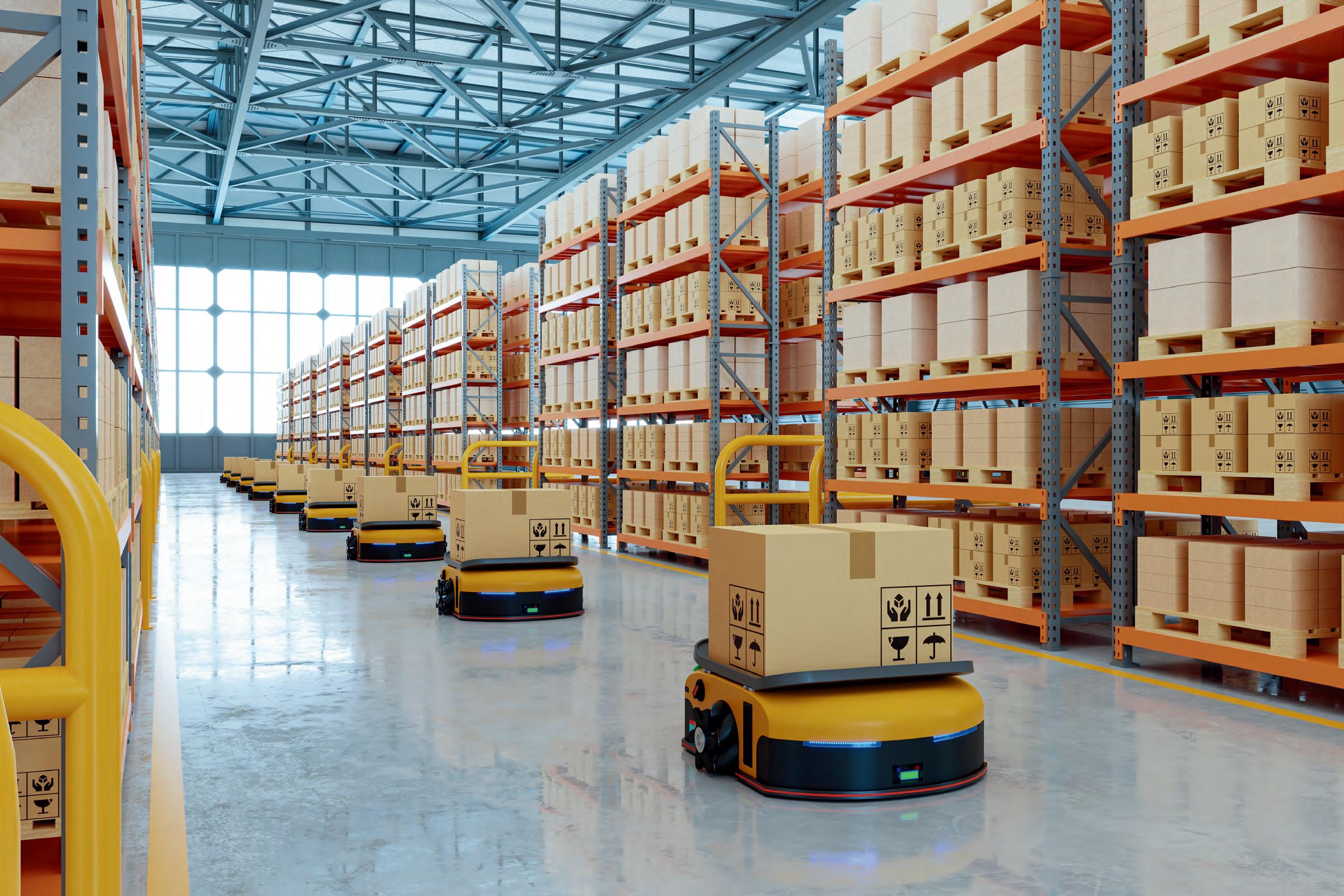

By Derek Clouthier

chain sector can lead down several different paths, and for those hoping to enter the field – or those looking to advance – there are some commonalities that cannot be
Matthew Drake is an associate professor of supply chain management at Duquesne University in Pittsburgh, Pa., and he is well aware he vast opportunities available in the logistics industry.

“When I talk to parents of high school students during recruiting or open houses, or even our current students trying to figure out their major, I tell them that the supply chain area is made up of so many different functions that all work together,” said Drake. “These functions require different sets of skills, or more significantly, the same skills but in different concentrations.”
Drake said it’s difficult to pinpoint any one specific career path in the supply chain sector, as there are many, each one unique.
“That’s exciting and really good for people getting into the field because there are so many opportunities,” he said. “But it’s also hard to figure out where you fit best. I start conversations with students by asking what they like to do, because you can find your home in
“The good aspect is that everyone can find a home in the supply chain that fits their skill set. The challenge is finding what fits your
One of the skills every supply chain professional needs is an abil-
ity to analyze data.
“Every supply chain job requires a good amount of data analysis –you can’t be a supply chain professional today without some degree of data analysis,” said Drake. “But it’s a spectrum – for some jobs, analysis is extremely important, for others, it may be less significant. On the other hand, we have interpersonal relationships; getting out there, talking with suppliers, talking with customers, collaborating on cross-functional teams. Some folks really gravitate toward that area because it fits their skills.”
One of the best ways to figure out which area of the supply chain industry fits your skill set is to test the waters through internships. As Drake pointed out, every single student in the program should have internships – as many as possible.
“It’s always a good learning experience, and I recommend purposefully getting internships in different areas,” he said. “One in procurement, one in planning, one in transportation logistics, so you can try out different areas and see what’s best for you.”
Getting internships in different industries also provides valuable experience that translates from one position to another. Drake added that if there is a specific industry a student wants to get into, there is nothing wrong with pursuing an internship with a company in that sector.
Rotational programs – where students are hired by a company, not for a specific job but to be given several different tasks – is an-
other way to gain experience in areas such as corporate offices, operations or international assignments.
“It’s a great experience because at the end, you work with the company to figure out where your skills will be best utilized and what you want to do,” said Drake. “You can give preferences about working conditions.”
Companies will often recruit students at job fairs for rotational programs, targeting the best candidates.
Movin’ on
As technology continues to change the landscape of the supply chain sector, students entering the industry and those already employed should focus on what Drake called a cross-functional perspective.
“People who want to move up in the organization need that cross-functional foundation and end-to-end perspective,” said Drake. “You may really know buying or procurement, but you may not understand how it connects with planning, engineering, inventory, and logistics. The supply chain is an interconnected web of processes and organizations.”
Drake said career advancement can happen in a vertical or horizontal way within an organization.
“We see people all the time who start in procurement, then move into planning and scheduling, logistics, sales, product management, marketing, or finance,” he said.
“The good aspect is that everyone can find a home in the supply chain that fits their skill set. The challenge is finding what fits your skill set best.”
– Matthew Drake, associate professor of supply chain management at Duquesne University
“There are lots of opportunities, which adds to the concept that there’s no one path.”
Drake suggested getting horizontal experience early on in a supply chain career, but ensuring you gain cross-functional knowledge to help with advancement.
“You’re not going to be the chief supply chain officer by being just a material planner, then material planning manager, then director,” said Drake. “You have to have cross-functional experience. Get as many different experiences as possible early on.”
But there is a fine line between gaining as much experience as possible and jumping from job to job too often.
“Don’t be someone who moves every nine
months thinking they’ve learned everything,” said Drake. “It might be 18 months, might be 24 months, but move when you’ve made a name for yourself and the organization is better because you made a difference.”
You don’t have to be a technology or AI expert to enjoy a fruitful career in the supply chain sector, but you do need to be competent in the area.
Depending on how much a company has invested in new technologies and AI – with some being ahead of the game and others well behind – knowing the fundamentals of a supply chain position will never change. Whether a buyer, inventory planner, material planner or transportation coordinator, an understanding of the position coupled with being an effective user of technology and AI is how employees will find success.
Staying up to date with ever-changing technology is also essential, which is where continuing education plays a key role.
Whether through conferences or webinars, micro-credentials, certifications or another degree program, those in the supply chain industry must stay current.
“The key is figuring out what’s best for you,” said Drake. “Where are your skill gaps for the job you want? What can you do now versus what you need to develop? Then determine the best way to address those gaps.”
RENEW YOUR COMPLIMENTARY SUBSCRIPTION! Simply complete this form today and Email to delon@turnkey.media Or Visit
https://www.insidelogistics.ca/subscribe/magazine/
(Email Required
YES, I WISH TO RECEIVE INSIDE LOGISTICS MAGAZINE FREE!
YES, I WISH TO RECEIVE INSIDE LOGISTICS E-newsletter FREE!
Choose your Edition: Print Digital Print & Digital
Signature:
Date:
PLEASE ANSWER THE FOLLOWING QUESTIONS TO QUALIFY FOR YOUR FREE SUBSCRIPTION:
1. Do you purchase, or influence the purchase, of goods and/or services related to distribution logistics, including warehousing operations (receiving, storage or shipping) or inventory control or materials handling? Yes No
2. If Yes, do you have plans to buy any of the following in the foreseeable future? (Check as many as apply)
(A) Forklifts and mobile materials handling equipment
(B) Racking, shelving and storage equipment
(C) Software, eg WMS, TMS, YMS, WES, etc
(D) Automated materials handling systems
(Z) None of the above
TRANSPORTATION SERVICES:
(E) Third-party logistics services
(F) Transportation services
(G) Real estate, warehouses, existing or new building
(H) Data capture and inventory control equipment
LTL Trucking Truck Load Trucking Intermodal Marine Rail Courier Air Freight None
3. What is your company's PRIMARY business?
MANUFACTURING (Check one only)
(01) Food & Beverage
(02) Consumer Durables
(03) Paper & Print
(04) Automotive Parts
(05) Clothing, Apparel & Textile Products
(06) Chemicals, Petroleum & Hazardous Waste
(07) Pharmaceuticals
(09) Computers & Electronics
(10) Transportation Equipment
(11) Lumber & Building Materials
(12) Manufactured Industrial Inputs
(98) Other Manufacturing (please specify)________________________________________________________________________
NON-MANUFACTURING (Check one only)
(13) Agriculture, Forestry, Fishing & Mining
(14) Transportation Services
(15) Storage & Warehousing Distributor
(16) Distributor
(17) Construction
(18) Retail Trade
(99) Others Allied to the Field (please specify)____________________________________________________________________
4. Which of the following categories best describes your PRIMARY function? (Check one only)
(A) Executive Management
(B) Purchasing / Procurement
(C) Engineering / Design Engineering / Research & Development
(D) Storage & Warehousing
(E) Financial / Administrative Management
(F) Plant Production / Operations / Maintenance Management
(G) Transportation & Distribution
(H) Materials Management
(Z) Other (please specify)____________ _
5. What is the approximate number of employees at this location?

C.H. Robinson has launched a new cross-border freight service that the company says can reduce shipping costs by as much as 40 per cent while offering shipment visibility up to 48 hours sooner.
According to C.H. Robinson, the service combines less-than-truckload freight in Mexico, manages customs clearance and bonded warehousing and leverages artificial intelligence to optimize routes throughout the U.S. and Canada.
“Here’s a scenario we see all the time,” said Jay Cornmesser, vicepresident for Mexico cross-border services. “Say you’re a company that assembles vehicle seats in the United States, and you’re importing foam, fabric, a wiring harness, a motor and switches from five different suppliers in Mexico. Those are coming to the border on five different trucks, five different transfer carriers are taking the loads across, and only then your freight might be consolidated for delivery to your warehouses or plants. You’re unnecessarily paying for too many trucks and unnecessarily paying for unused space on each truck.”
The company said its proprietary Optimizer technology uses real-time data to reduce costs, maximize trailer use and improve efficiency.

The Raymond Corporation has rolled out a new lithium-ion-powered stacker designed to boost productivity and cut costs for operators in warehousing, distribution, manufacturing and retail.
The Raymond RBS26-F Stacker, part of the company’s Raymond Basics line, is built for handling skids, crates, containers and platforms that lack bottom boards.
“At Raymond, we’re always looking for options that support the variety of needs that our customers have to efficiently and securely enhance their operation,” said Mike Distin, product manager of Raymond Basics. “Powered by lithium-ion, the Raymond RBS26-F Stacker delivers the performance operators need to reliably and affordably increase productivity within their operations.”
The unit offers electric travel, lift and lower capabilities, handling loads of 1,480 to 2,600 pounds at heights of 72 to 114 inches. Features include turtle speed, creep mode and dual thumb controls for maneuverability, as well as safety measures such as PIN-based access, reduced turning speeds and a standard load backrest.
The stacker is equipped with lithium-ion batteries that provide up to two hours of power and support opportunity charging to extend operating time.

Swisslog has expanded its warehouse automation offerings with a new line of autonomous mobile robots (AMRs). The IntraMove series is engineered for horizontal transport of loads up to 3,000 kilograms and leverages artificial intelligence to optimize routing and respond to changing conditions.
“Our customers are increasingly looking for horizontal transport solutions capable of handling heavier loads and adapting to dynamic and frequently changing conditions,” said Thomas Balzarek, AMR solution manager, Swisslog Americas. “Our new AMRs are ideal for point-to-point pallet transport in sectors such as food and beverage, fashion and general merchandise, as well as inter-industrial applications. The advantages they offer are quick deployment and flexible operation, ease of changing routes and delivery points and adaptability to support business growth.”
lifting
CANADA’S SUSTAINABILITY goals increasingly rely on transforming supply chains to reduce waste, conserve resources and close the loop on industrial materials. While tire management may not be the first sector that comes to mind, Kal Tire, a Canadian-owned, family-operated company founded in 1953 in Vernon, B.C., is proving that even traditional industries can play a pivotal role.
With 275 retail locations coast to coast, five warehouses — including a new facility in Ontario that opened in 2025 — and mining tire operations spanning five continents, Kal Tire has become a leader in sustainable tire lifecycle management.
Dany Veipans, procurement and remanufacturing specialist at Kal Tire, spoke at the CITT’s annual Canada’s Logistics Conference in Toronto earlier this year, diving deeper into the impact the company and its processes are having on the environment.
Kal Tire’s sustainability impact centres on its circular processes, which include retreading, devulcanization and thermal conversion. It is currently the only Canadian company offering all three methods, combining innovation and environmental responsibility to extend tire lifecycles and reduce resource consumption.
Retreading is at the heart of Kal Tire’s sustainability efforts. In this process, worn tires are stripped down to their base structure and a new tread is applied to meet manufacturing specifications. This allows about 70 per cent of the tire material to be reused, reducing the need for raw rubber, steel and carbon black.
To understand the environmental value of retreading, Kal Tire performed an independent study that compared tire wear. Using a premium tire as the benchmark, a retreaded tire achieved 92 per cent of the mileage, while a single-use tire reached only 34 per cent. Without retreading, used tires typically enter provincial recycling programs and are converted into products such as car mats, mulch or barbells. Once those products reach the end of their life, they are no longer collected for recycling, representing a permanent loss of material. Retreading, in contrast, keeps valuable resources


circulating in the tire supply chain.
Each year, Kal Tire collects five to six million pounds of buffings — the rubber shaved from tires during the retreading process. These buffings are cleaned and resized, and impurities such as rocks, wood and fibre are removed. The material is then granulated to the size of sugar, ready for the next stage: devulcanization.
The devulcanization process, tested in collaboration with the University of Waterloo, transforms granulated buffings into 10-kilogram rubber slabs that substitute for high-quality rubber materials in new tires. About 25 per cent of the devulcanized material is further processed into rubber compounds that are reincorporated into retreaded tires, effectively creating a circular material loop that reduces dependence on virgin resources.
This innovation demonstrates how industrial waste can be transformed into a high- value input, reinforcing a sustainable Canadian supply chain while conserving energy and reducing greenhouse gas emissions associated with producing new rubber.
The third process Kal Tire offers is thermal conversion in the mining tire sector. For large mining tires, logistics poses a significant sustainability challenge. Their size and weight mean simply transporting them to a retreading facility can generate more CO2 than other parts of the tire lifecycle.
To address this, Kal Tire developed and built a thermal conversion facility in Chile, enabling material recovery closer to mine sites.
Thermal conversion breaks tires into reusable components, including oil, carbon black and steel, while also generating syngas for facility energy needs. By processing tires near their point of use, Kal Tire reduces emissions associated with transport and provides a scalable model for mining operations worldwide.
Dr. Darryl Moore of Kal Tire emphasizes that sustainability cannot be achieved by one company alone:
“Sustainability is a team effort. Kal Tire can’t do all of this for all tires on our own. Customers must want to retread, customers have to want to get away from single-use solutions. Even our competitors in the tire market have to be on board. It’s not a one-company solution, but we are at the forefront of developing these technologies.”
This approach highlights a critical principle: environmental sustainability in supply chains requires collaboration across manufacturers, distributors, competitors and customers. Retreading and circular processing are only effective when demand exists to keep materials circulating instead of disposing of them.
Kal Tire demonstrates that even traditional industries can play a significant role in Canada’s environmental sustainability. Through its comprehensive tire lifecycle initiatives — retreading, devulcanization and thermal conversion — the company keeps millions of pounds of material circulating within the economy, reduces greenhouse gas emissions and conserves natural resources. More importantly, Kal Tire’s model underscores the collaborative nature of supply chain sustainability: technology, infrastructure and customer engagement must align to create meaningful environmental impact.
In a country striving to meet ambitious climate and circular economy goals, Kal Tire’s practices illustrate how innovation and industrial responsibility can intersect to produce measurable environmental benefits across Canada’s supply chain.
WITH THE ECONOMIC uncertainty we are currently facing, companies are looking for ways to reduce expenses and shore up their financial position. One way to do that is to consolidate spaces. Whether you are merging multiple sites into one location or looking to share a facility with another business, there is a lot to think about to ensure the transition is done safely. And if proper planning is not done in advance, you could find yourself dealing with a host of hidden costs.
Making a move quickly because of financial pressure is usually how companies get into trouble in these situations. For example, I have worked with companies that rushed into a new space to save on costs but then discovered their fleet of forklifts did not fit properly in some of the aisles or around some corners, posing a serious collision risk. The only option at that point was to invest in new equipment.
Plan for a smooth transition
If you are moving to a new warehouse space, consider the following before committing to relocation.
1. Fire and building code compliance
Fire departments across Canada require unobstructed access to all sides of a building. In Ontario, for example, the fire code mandates that fire hoses must reach every part of the facility within prescribed distances. The National Building Code of Canada also requires sprinkler systems in most industrial workplaces. Before moving to a new space, confirm that it is compliant with the fire and building code for your jurisdiction, particularly if it is an older building that may lack coverage to meet current safety standards.
2. Equipment accessibility and layout
Canadian warehouses often use Class II and III forklifts, which have longer forks for palletized goods. As I described in the above example, narrow aisles and tight corners in repurposed buildings create collision hazards, violating CSA B335 – Safety Standard for Lift Trucks. Understanding whether racking


CARL BONELLO, CRSP, PMM, Specialized consultant, warehouse & distribution for Workplace Safety & Prevention Services.
ters and humid summers mean that a robust HVAC system is crucial. Without it, you could end up with unsafe working conditions and damaged products. If your operation involves hazardous material, adequate ventilation is necessary. Make sure the new building has been retrofitted to meet your specific needs.
Whether you are moving racking into the new warehouse space or using a system that is already there, it is your responsibility to ensure all racking is rated for seismic loads. Automated systems, such as vertical carousels, are becoming more common in Canadian logistics hubs because they can improve efficiency, accuracy and safety in high-volume environments. However, they are often installed without consideration for proper access for cleaning and maintenance. This must be factored in when designing your new layout.
systems, cranes and forklifts will function safely in the new space is critical. Provincial fire codes mandate minimum aisle width for both pedestrian and equipment traffic, so be sure to confirm that your new layout meets these requirements as well.
3. Structural engineering and weight restrictions
Overhead crane systems require structural assessments to ensure the roof and walls can bear the dynamic loads. Heavy racking and storage systems require concrete floors that can safely hold their weight. You must confirm that the new warehouse space meets the legislative requirements for your jurisdiction. For example, WorkSafe BC regulations demand certified engineering reviews before crane installations. In Ontario, the Occupational Health and Safety Act require load ratings to be visibly posted and verified by a professional engineer.
4. HVAC and climate control
One aspect that often gets overlooked when a company relocates to a new warehouse space is the HVAC capacity. Cold Canadian win-
Sharing a warehouse facility with another business can be an effective way to reduce operating costs. However, it needs to be with the right partners, and all operations need to be compatible. For example, if one business handles hazardous materials, all workers in a shared space could be exposed, which means they will all need the proper tools, equipment and training to protect themselves. An understanding of the heating and cooling needs of each business is important as well. If your workers are sharing a workplace with others from another company, make sure that is reflected in your violence and harassment policy and program. In fact, if you are sharing a facility, it may be a good idea for both businesses to discuss their procedures and ensure they are on the same page.
Whatever the reason is for moving to a new warehouse, whether it is a shared space, a smaller space, or simply a new location, it would be a mistake to consider only the bottom line. Do your due diligence for a cost-effective transition that will provide your business with future sustainability.






